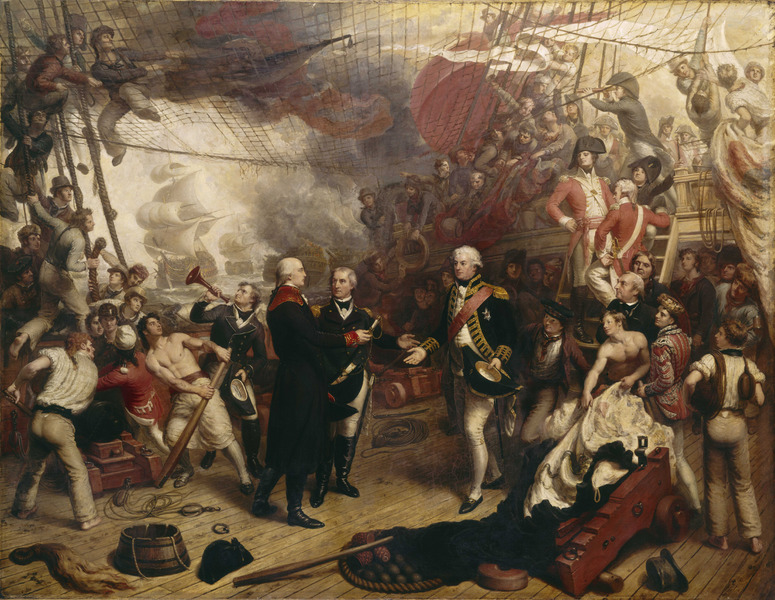Image: Admiral Duncan Receiving the Sword of the Dutch Admiral de Winter at the Battle of Camperdown, 11 October 1797 RMG BHC0506f

Description: An interpretation of Admiral Duncan receiving the surrender of the Dutch Admiral de Winter, following the Battle of Camperdown, painted 30 years after the event. Admiral Duncan countered the threat of French invasion when he defeated the Dutch fleet at Camperdown in 1797. His victory was regarded as one of the most important naval actions of its time. He was commander of the North Sea fleet blockading Holland when the Dutch fleet, commanded by Admiral de Winter, appeared. A very hard-fought action ensued with many casualties. Duncan's own ship, the 'Venerable', 74 guns, took many hits. When Duncan's flag was shot from the main topmast, he retrieved it himself and, in a famous incident, seaman Jack Crawford of Sunderland climbed up to reattach it to the shattered masthead. With de Winter's surrender, Admiral Duncan was able to claim 11 ships as prizes, from an enemy fleet of just 18. The painting shows the quarter-deck of Duncan's flagship, 'Venerable', viewed from the port side, with Duncan, de Winter and Captain Fairfax of the 'Venerable' standing in the centre. Duncan is on the right facing left, in full-dress uniform with the sash and star of the Order of the Bath. He holds his hat in his left hand and his right hand prepares to receive de Winter's sword. Fairfax introduces de Winter to Duncan. Standing in profile to the right, de Winter is shown conceding his sword to Duncan. In the background to the left, a lieutenant holds a speaking trumpet. There is a gun crew running out a gun, and men in the mizzen shrouds and netting. The seaman pulling at a fallen flag on the anti-boarding netting may be intended to represent Jack Crawford, though Duncan's command flag at Camperdown was plain blue and the incident occurred earlier in the action. In the right foreground, a gun carriage has the ensign of the Dutch flagship 'Vrijheid', 74 guns, thrown over it. The group watching the surrender include a sailor, drummer and a boy seaman with his back to the viewer. To their left and immediately behind Duncan is a boy in a tam o'shanter, presumably his servant. Two marine officers are on the companionway to the poop, which is crowded with people. In the background are several ships: one, the Dutch 'Hercules', 64 guns, is shown on fire. Drummond's interpretation positions the figures in highly stylized attitudes. Figures encircling the main action in the foreground resemble a frieze: limbs, backs and elbows form a rhythmic counterpoint to the static main action. In the foreground the artist intentionally arrests the eye with a still life of ropes, a hat, cannon balls and ship's equipment. The painting was exhibited at the British Institution in 1827 and is one of four similarly patriotic works competitively commissioned by the B.I. at £500 each for the Naval Gallery at Greenwich during its early years.
Title: Admiral Duncan Receiving the Sword of the Dutch Admiral de Winter at the Battle of Camperdown, 11 October 1797 title QS:P1476,en:"Admiral Duncan Receiving the Sword of the Dutch Admiral de Winter at the Battle of Camperdown, 11 October 1797 " label QS:Len,"Admiral Duncan Receiving the Sword of the Dutch Admiral de Winter at the Battle of Camperdown, 11 October 1797 "
Credit: http://collections.rmg.co.uk/collections/objects/11998
Author: Samuel Drummond
Permission: The original artefact or artwork has been assessed as public domain by age, and faithful reproductions of the two dimensional work are also public domain. No permission is required for reuse for any purpose. The text of this image record has been derived from the Royal Museums Greenwich catalogue and image metadata. Individual data and facts such as date, author and title are not copyrightable, but reuse of longer descriptive text from the catalogue may not be considered fair use. Reuse of the text must be attributed to the "National Maritime Museum, Greenwich, London" and a Creative Commons CC-BY-NC-SA-3.0 license may apply if not rewritten. Refer to Royal Museums Greenwich copyright.
Usage Terms: Public domain
License: Public domain
Attribution Required?: No
Image usage
The following page links to this image:

